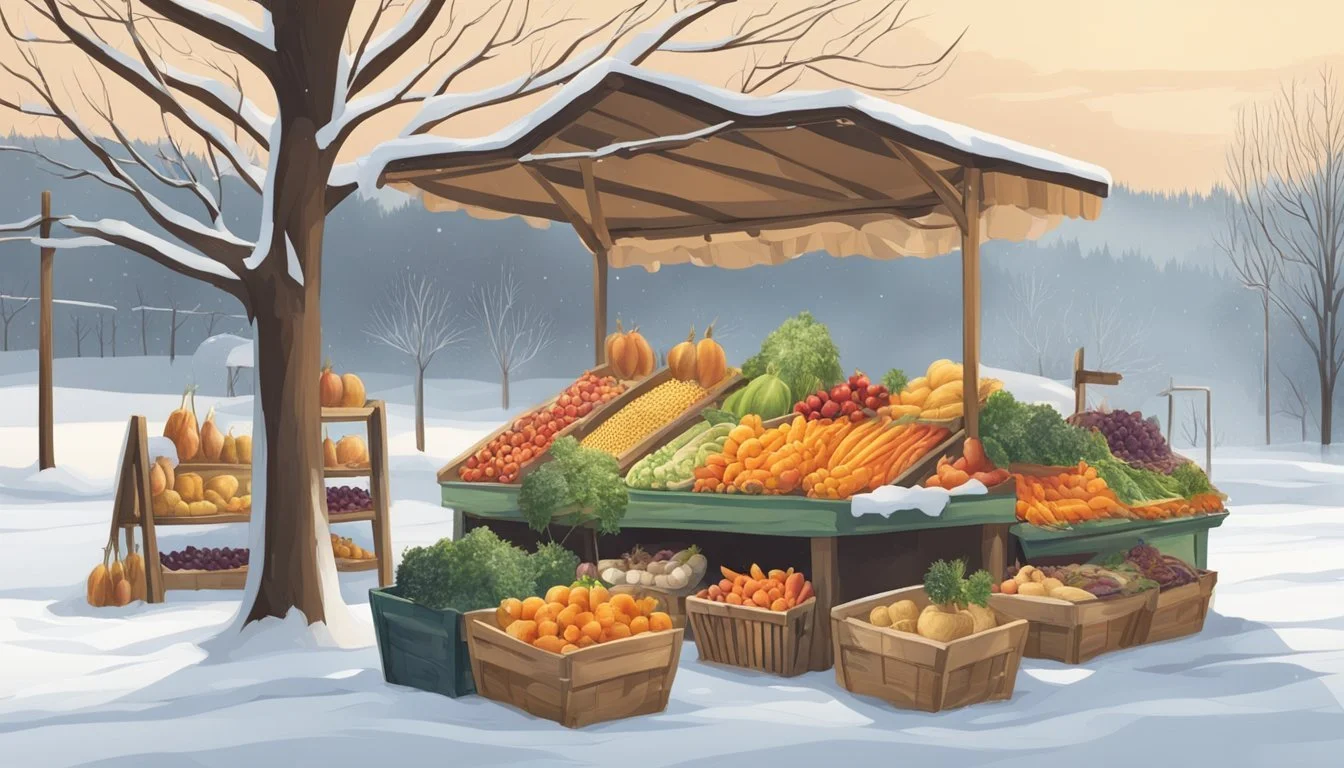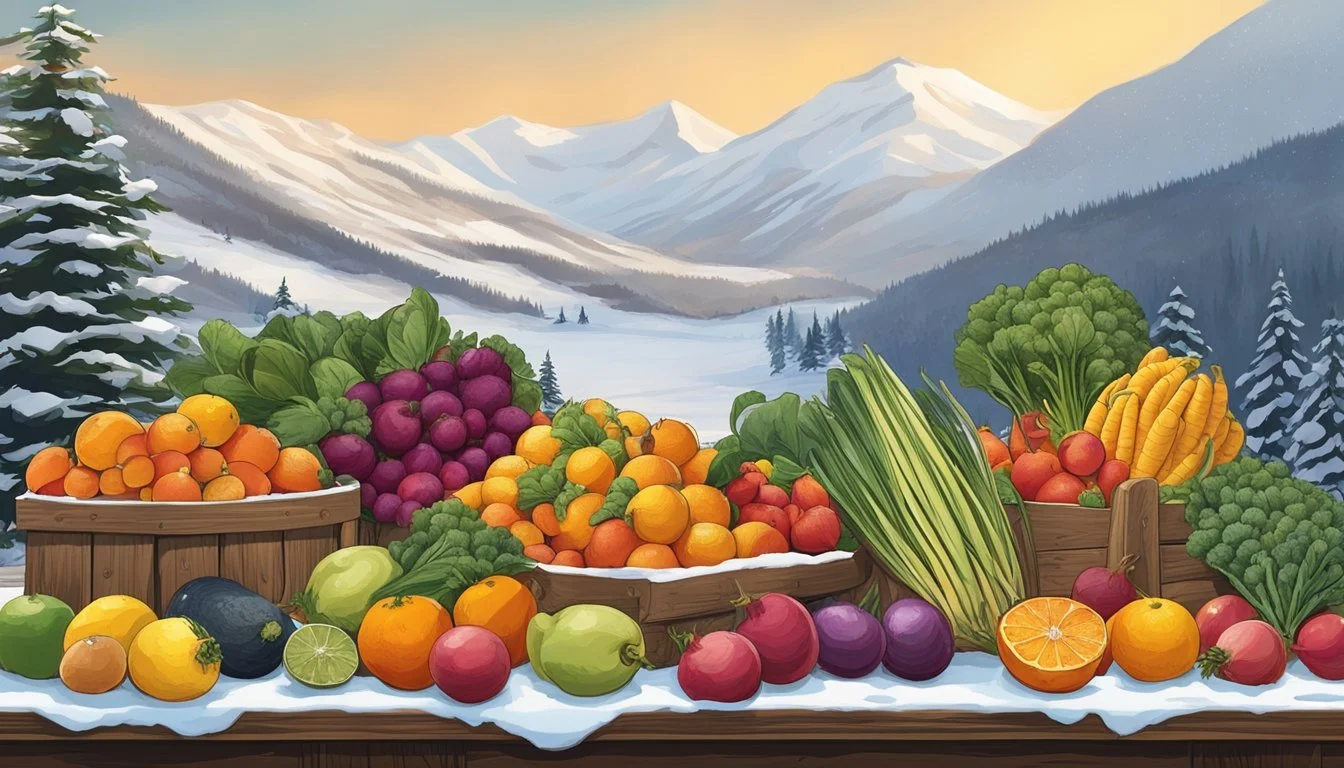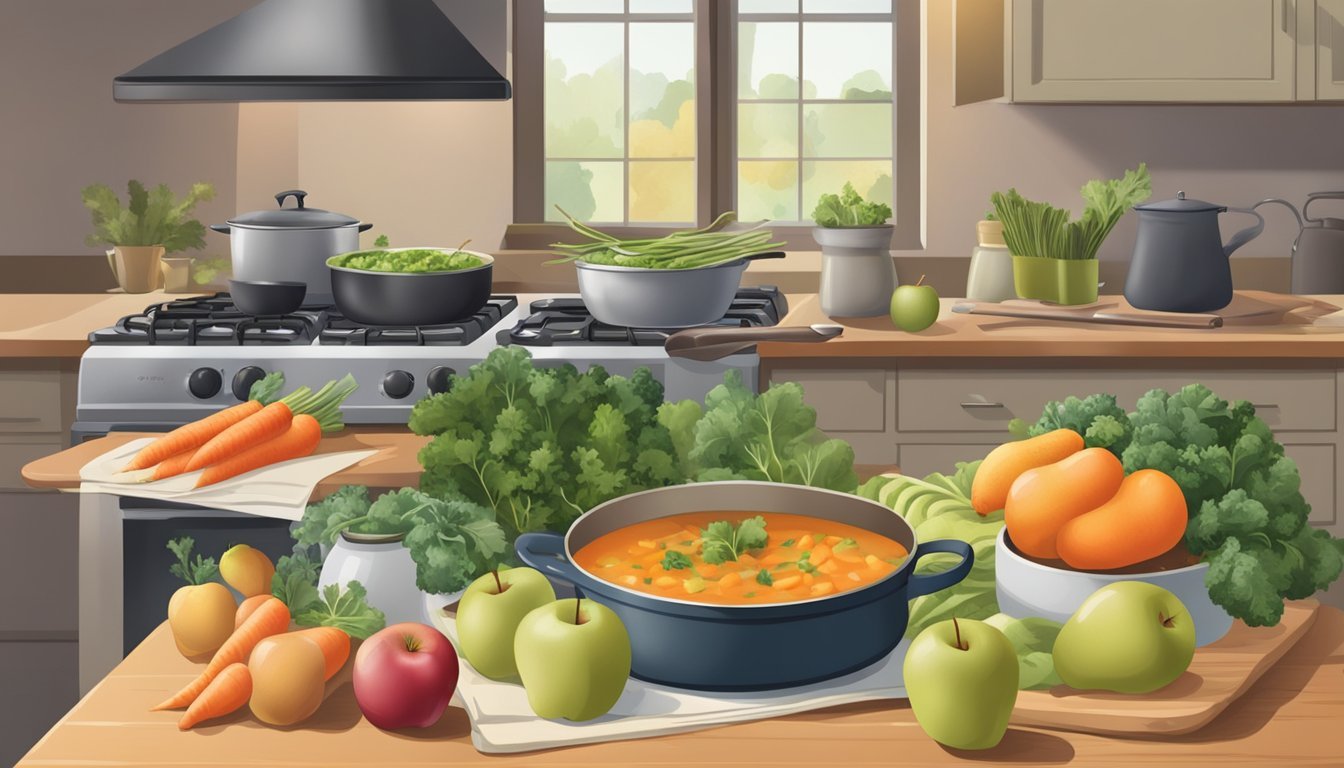West Virginia Seasonal Fruit & Vegetables in January
A Fresh Start to Healthy Eating
This Article is Part of our West Virginia Seasonal Fruit & Veg Calendar
In the heart of winter, West Virginia's seasonal offerings are reflective of the state's robust agricultural practices, which primarily consist of family-owned farms. January in the Mountain State is a time when the fields are mostly at rest, yet the region's markets and farm stands continue to provide a selection of seasonal produce that thrives in the cooler months. These include hearty greens and storied root vegetables, which are staples in the local cuisine and are celebrated for their nutritional value and versatility in cooking.
Fruits are scarce in West Virginia during January, as the cold winter climate is not conducive to growing traditional fruit crops during this time. However, stores may still carry fruits from other regions or those that have been preserved. On the vegetable front, West Virginians turn to produce that can withstand the harsher temperatures. Kale, (What wine goes well with kale?) known for its hardiness, along with other cruciferous vegetables like broccoli (how long does broccoli last?)and cauliflower (how long does cauliflower last?), become prominent ingredients in meals, offering both flavor and nutrition to dishes during the cold season.
Incorporating these seasonal vegetables into winter meals is a way for residents and chefs alike to maximize flavor while supporting local agriculture. January's limited but focused selection emphasizes the importance of eating seasonally and regionally, reflecting West Virginia's commitment to farm-to-table values even during the more challenging growing months.
The Importance of Seasonal Eating
Eating seasonal produce aligns with the natural crop production cycle, leading to a multitude of benefits across nutrition, environment, and local economies.
Nutritional Benefits
Seasonal fruits and vegetables are harvested at their peak of freshness, which means they are richer in vitamins and minerals. For instance, winter staples like squash and root vegetables in West Virginia provide essential nutrients and are likely to have a higher nutritional content right after harvest. The freshness of seasonal produce also contributes to better flavor and health outcomes, such as enhanced immunity and disease prevention.
Environmental Impact
Choosing seasonal produce can lessen the environmental footprint associated with food. It often reduces the distance food travels, which lowers greenhouse gas emissions. In West Virginia, opting for local and seasonal agriculture means less reliance on resources for storage or transportation. This practice supports sustainability efforts and prioritizes the environment.
Supporting Local Farmers
When individuals purchase seasonal fruits and vegetables, they bolster the local economy in West Virginia. Spending money on local produce translates to support for family-owned farms, with 95 percent of them in West Virginia being family-owned. This helps maintain local agricultural traditions and contributes economically by keeping money within the community.
January Seasonal Produce Overview
In January, residents and visitors of West Virginia can enjoy a collection of hardy produce that thrives in the cooler temperatures and find ways to incorporate these local ingredients into healthy meals.
Typical Weather Patterns
January in West Virginia is characterized by cold and often snowy conditions. Winter asserts itself with average temperatures ranging from highs around 40 degrees Fahrenheit to lows in the 20s. These weather patterns are significant in determining what fruits and vegetables are hardy enough to be available during this season.
Crop Availability
Vegetables:
Kale
Broccoli
Cauliflower
Fruit:
Citrus fruits (oranges and lemons)
Most of the locally available produce during January in West Virginia includes robust vegetables like kale, broccoli, and cauliflower; these vegetables can withstand the chilly weather. Citrus fruits, although not locally grown, are prevalent in markets due to their peak season in warmer climates and ability to be transported. They are known for providing vitamin C, which is particularly beneficial for immune support during the cold season.
Fruits in Season
In West Virginia, January is not the peak season for an abundance of fruits; however, certain types remain available due to their longer storage capability or late growing season.
Apples
In January, apples are a particularly resilient fruit that can be found in West Virginia. Though not harvested this time of year, many varieties store well and remain available to consumers. They can range from sweet to tart in flavor, suitable for fresh eating or cooking.
Storage Varieties Available:
Fuji
Granny Smith
Red Delicious
Pears
Pears, much like apples, have certain varieties that store well and are available during the winter months. They maintain a sweet, aromatic profile and a buttery texture, making them ideal for both raw and cooked dishes.
Commonly Available Varieties:
Bosc
D'Anjou
Vegetables in Season
In January, West Virginians have access to a robust selection of vegetables despite the cold winter months. The state's winter harvest offers hearty root vegetables and nutritious leafy greens that are ideal components for warm, wholesome dishes.
Root Vegetables
Carrots: They thrive in the cooler temperatures, producing a sweet and crisp flavor.
Potatoes: A versatile staple, potatoes harvested in the winter can range from starchy russets to waxy reds.
Turnips: These are available and offer a slightly peppery taste that mellows when cooked.
Leafy Greens
Kale: A hardy vegetable, kale can withstand frost, which often enhances its flavor.
Greens: Collards and other hearty greens are also in season and can be used in a variety of warming recipes.
Planning for Seasonal Consumption
In January, West Virginia consumers face a limited selection of fresh, locally-grown produce due to the region’s cold winter. However, they can still engage in seasonal consumption by sourcing from local entities and understanding proper storage techniques to maintain freshness.
Sourcing From Local Markets
West Virginia's markets in January mainly offer goods like stored root vegetables and winter greenhouse crops, while some imported items can also be found. Consumers should look for farmers' markets and farm stands, which supply the following:
Apples, preserved from fall harvest
Winter squash, stored properly from previous seasons
Hearty greenhouse-grown greens like kale and spinach
By connecting with local farmers or visiting markets that support local agriculture, consumers can gain access to the freshest food available in the winter months and support the local economy.
Storing for Freshness
Effective storage is essential to extend the life and freshness of produce purchased in January. Here are some fundamental storage tips:
Root Vegetables (such as carrots and beets): Store in a cool, humid place, ideally in the refrigerator, in a perforated plastic bag or wrapped in a damp towel. This can keep them crisp for several weeks.
Winter Squash: Keep in a cool, dry place with good ventilation. They can last for several months when stored at a temperature between 50-60°F (10-16°C).
Apples: Place in the crisper drawer of the refrigerator in a plastic bag with holes or on a layer of newspaper. This could maintain their freshness for up to three to four weeks.
Consumers should be mindful of the signs of produce nearing the end of its freshness to incorporate it into their meal planning promptly, avoiding food waste and ensuring they enjoy their food at its best quality.
Cooking and Recipes
In West Virginia during January, the cold season calls for heartwarming dishes and a nutritional balance to combat the brisk weather. Recipes and cooking methods focus on maximizing the flavor and health benefits of local, seasonal produce.
Winter Comfort Foods
Hearty stews and soups are staples in the West Virginia winter diet, as they incorporate a range of seasonal vegetables in a warming, satisfying meal. One can find recipes like Roasted Root Vegetable Stew that make use of January-harvested beets and carrots. Another popular dish is a creamy Butternut Squash Soup, often seasoned with a touch of sage to complement the squash's sweetness. These dishes not only provide warmth but also an abundance of vitamins and fiber.
Key Recipe Suggestion: Roasted Root Vegetable Stew
Primary Vegetables: Beets, Carrots
Key Spices: Thyme, Rosemary
Healthy Eating
January's harvest supports healthy eating with an abundance of kale and other cruciferous vegetables like broccoli and cauliflower. These can be transformed into nutritious salads or sides. Cooking methods such as steaming or sautéing help retain the vegetables' nutritional profile and flavor. Citrus fruits, in season, supply a generous amount of vitamin C, perfect for dressings or to add a fresh note to dishes.
Healthy Recipe Choice: Kale and Citrus Salad
Ingredients: Kale, Oranges, Lemon Dressing
Cooking Tip: Massage the kale with a bit of olive oil to soften the leaves before adding toppings.
Gardening Tips for West Virginians
January is the planning and preparation phase for gardening enthusiasts in West Virginia. This month, they focus on cultivating plants indoors and getting ready for the spring growing season.
Indoor Gardening
In West Virginia, gardeners take advantage of January to start warm-season crops indoors. Seedlings nurtured inside can grow without the threat of frost, ensuring a head start once spring arrives. Essential indoor gardening activities include:
Selecting Seeds: Choosing suitable varieties that can thrive in West Virginia's climate.
Starting Seedlings: Using pots filled with nutrient-rich soil, seeds are planted and kept in well-lit, warm areas of the home to germinate.
Equipment Checklist:
Pots or seed trays
High-quality soil mix
Grow lights or a sunny window
Watering can or system
Labels to identify plant varieties
Preparing for Spring Planting
Preparation for spring involves understanding the local climate and the optimal timing for transferring seedlings outdoors. For the various planting zones within the state, frost dates are crucial indicators for planning:
Zone A:
Estimated last frost: May 10
Estimated first frost: October 5
Zone B:
Increased growing season compared to Zone A.
Key tasks in January include:
Soil Testing and Amendment: Testing soil in the garden beds to determine nutrient needs.
Garden Planning: Mapping out where each plant will go, considering sunlight and companion planting.
Equipment Maintenance: Sharpening tools and ensuring all equipment is in good condition for use.
By attending to these tasks, West Virginians position themselves for a fruitful gardening season ahead.
Conclusion
In January, West Virginia's climate dictates a more select availability of fresh produce; however, this limitation is an opportunity to celebrate the season's bounty. Vegetables like kale, which thrives in cooler conditions, become staple ingredients for nutritious meals. Alongside kale, other cruciferous vegetables such as broccoli and cauliflower also endure the winter weather, offering a diverse range for healthy diet options.
Although fruit offerings are leaner during the winter months, consumers can typically find a variety of citrus fruits that are brought to the region's markets. These fruits, renowned for their vitamin C content, are not only beneficial for immune support during the colder season but also provide a splash of brightness to winter dishes.
Residents and visitors should note the array of farmers' markets across West Virginia. They present a chance to purchase these seasonal items, along with potentially spotting some indoor-grown produce such as herbs and greens. It's important to remember that while supermarket options are available, local farm stands and markets might offer fresher picks as they come from the nearby family-owned farms which dominate the state's agricultural landscape.
Here is a crisp look at the seasonal produce in West Virginia during January:
Vegetables Fruits Kale Citrus Fruits (e.g., Oranges, Lemons) Broccoli Cauliflower
By focusing on these seasonal offerings, individuals not only support the local agricultural economy but also enjoy the freshest flavors and highest nutritional content available during West Virginia's winter season.









